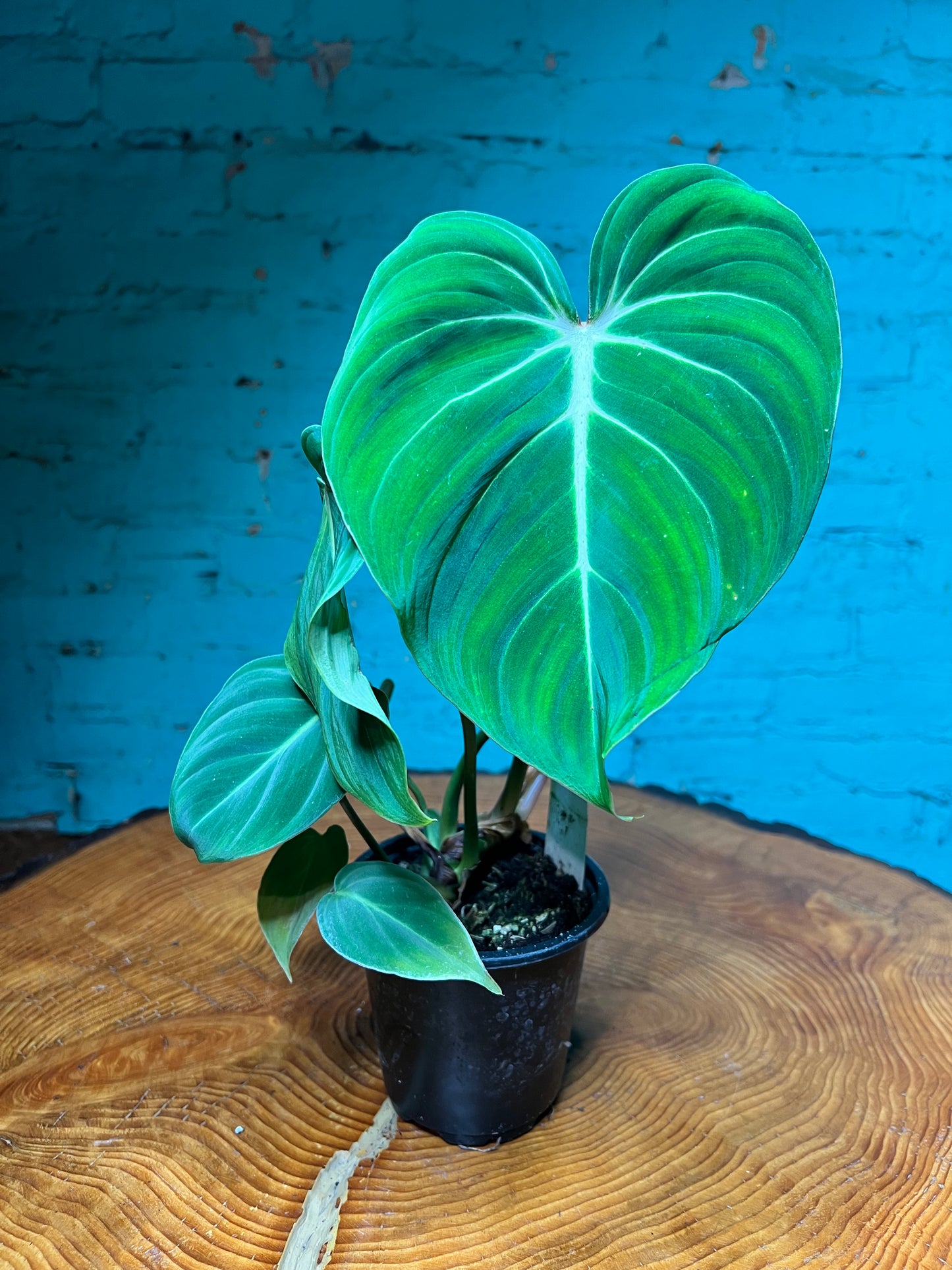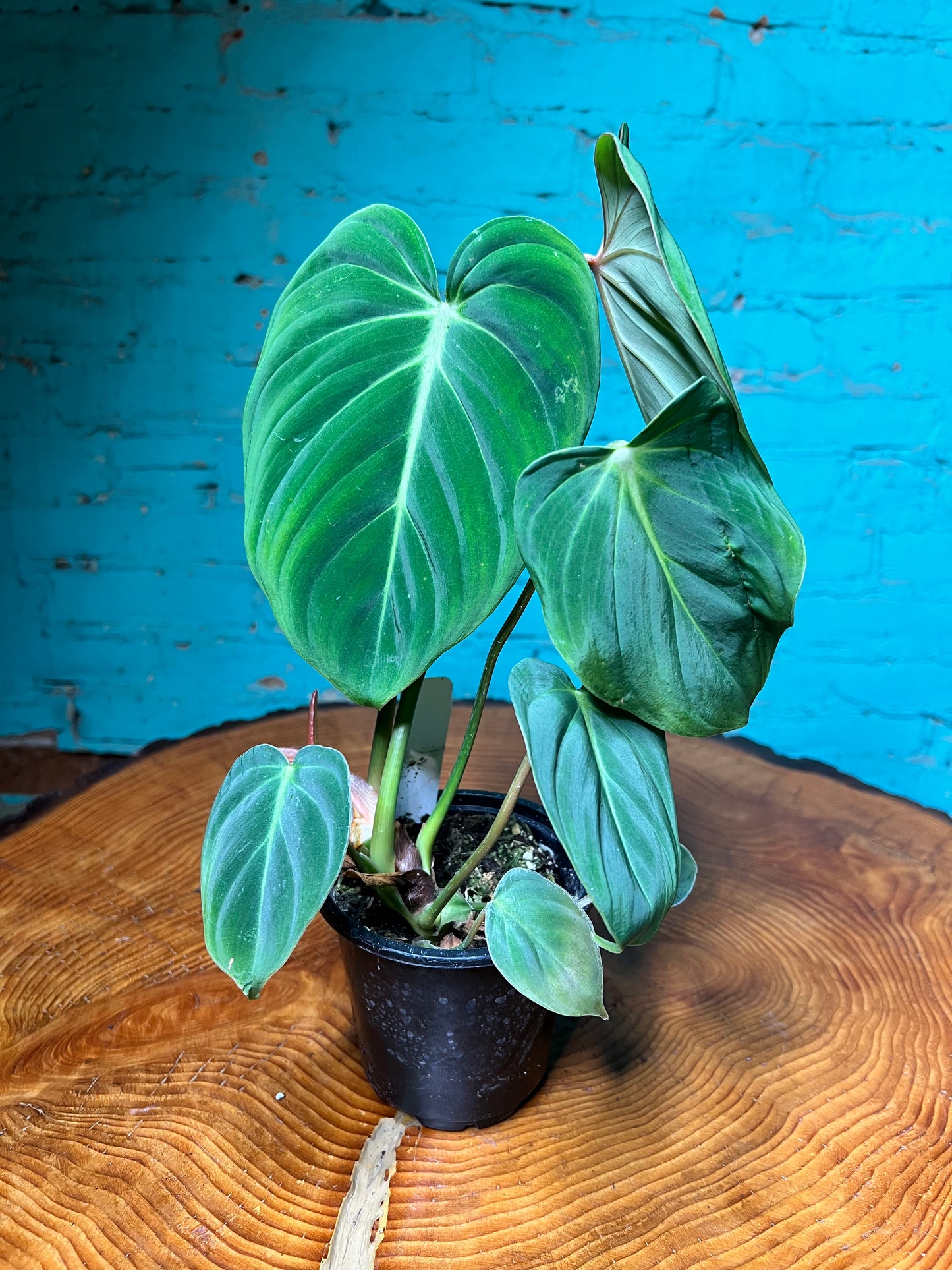The Rooted Plant Shop
Philodendron Gloriosum 4”
Philodendron Gloriosum 4”
Couldn't load pickup availability
The Philodendron gloriosum is a striking and popular vining plant known for its large, heart-shaped leaves with bold white veining. It is a relatively easy-to-care-for species, making it a favorite among plant enthusiasts. Below is a detailed care guide to help your Philodendron gloriosum thrive:
Origin:
- Native to Colombia and Venezuela: This plant is native to the tropical rainforests of South America, where it grows as a ground-dwelling or crawling vine in humid, low-light environments.
Care Guide for Philodendron Gloriosum:
Light:
- Bright, indirect light: Philodendron gloriosum prefers bright but indirect light. Direct sunlight can scorch the leaves, so place it near a window with filtered light or in a spot with bright, indirect light throughout the day.
- Low light tolerance: While it can tolerate lower light conditions, the growth will slow down, and the leaf coloration may not be as vibrant. Avoid too much direct sun, as it will burn the leaves.
Watering:
- Moderate watering: Water when the top 1–2 inches of soil are dry to the touch. The plant likes to be kept moist but not soggy. Be cautious of overwatering, as the plant is prone to root rot.
- Water thoroughly: When you water, make sure to water thoroughly until it drains out of the bottom of the pot. This helps ensure the roots are evenly hydrated.
- Reduce watering in winter: During the cooler months, Philodendron gloriosum slows down its growth, so water less frequently, allowing the soil to dry out a bit more between waterings.
Temperature and Humidity:
- Warm temperatures: It thrives in warm temperatures between 65–80°F (18–27°C). It can tolerate temperatures a bit above or below this range but avoid drafts or sudden temperature fluctuations.
- High humidity: Like most tropical plants, Philodendron gloriosum thrives in higher humidity levels (50% or higher). If your home is dry, especially in winter, increase humidity by using a humidifier or placing the plant on a humidity tray. Regular misting can also help.
Soil:
- Well-draining, rich soil: Use a lightweight, well-draining potting mix. A mix designed for aroids or a combination of peat, perlite, and orchid bark is ideal. This helps with drainage while keeping enough moisture for the plant’s roots.
Fertilizing:
- During the growing season: Feed your Philodendron gloriosum with a balanced liquid fertilizer (half-strength) every 4–6 weeks during the spring and summer, when the plant is actively growing.
- Reduce fertilizing in winter: In the fall and winter, reduce feeding, as the plant is in a period of dormancy and growth slows down.
Potting & Repotting:
- Repotting: Repot every 1–2 years, or when the plant outgrows its pot or when the soil begins to break down. Choose a slightly larger pot, but avoid going too large, as this can cause the soil to stay too moist.
- Proper drainage: Always use a pot with drainage holes to prevent excess water from sitting at the bottom and causing root rot.
General Care Tips:
- Leaf care: Wipe leaves gently with a damp cloth to remove dust and keep them looking glossy.
- Support for vines: Philodendron gloriosum is a creeping vine and may benefit from some support, such as a moss pole, to climb or trail on. Providing vertical support can encourage a more structured, upright growth habit.
- Pruning: While minimal pruning is required, you can trim back leggy or unhealthy growth to maintain the plant's shape. Prune just above a node to encourage new growth.
- Pest management: This plant is generally pest-resistant but can occasionally be susceptible to common houseplant pests like mealybugs, spider mites, or aphids. Regularly inspect your plant for pests and treat promptly with insecticidal soap or neem oil if necessary.
Common Issues:
- Yellowing leaves: Yellow leaves are often a sign of overwatering or poor drainage. Ensure that the plant isn’t sitting in water and that the soil is draining well.
- Brown tips: This can be due to underwatering, low humidity, or inconsistent watering. Ensure proper humidity and watering routines.
- Leggy growth: If the plant isn’t getting enough light, it may become leggy, with long spaces between leaves. Move it to a brighter spot with indirect light.
- Drooping leaves: This is typically a sign that the plant needs water. However, drooping can also occur if the plant is stressed, so check other factors like humidity and temperature.
Share


Let customers speak for us
from 373 reviewsThe way they wrap the plant in the insulation, it creates a tube of warmth for the plant with the heat pack at the bottom.

This is so fun! I received choices on how I would get my plants! 🌱 The one that was sent was perfect along with a cactus and another cute succulent! She has helped me with so many plant issues! Thanks Mel for being an amazing small business!

Everything came beautifully packaged and in such good shape. Thank you!!

I love the way Rooted plant shop wrapped up the plants n tight so they can get here in one piece. Mel also likes to educate us on plants. She makes it really easy helps us of how to take care of the plants. Thank u very much Mel for everything u do for us bottom from my heart. I appreciate u

Shipping was so fast. The plant was so safe and secure when it arrived. Mel is so great, and so knowledge. Never had a disappointing purchase.

The rooted plant shop is impeccable. I am and will continue to be a returning customer. Seller/owner very professional and very knowledgeable in her field of plants. Packaging is packed with great care.. fast shipping as well.. and the plants are as described, healthy and gorgeous!

I bought a Dieffenbachia from Mel she’s beautiful. The third leaf is just now coming out. I can’t be more happier with her.
The Spanish moss from The Rooted Plant Shop are ABSOLUTELY STUNNING!!! Incredibly healthy and full!! So happy and can’t wait for more to be stocked!!











